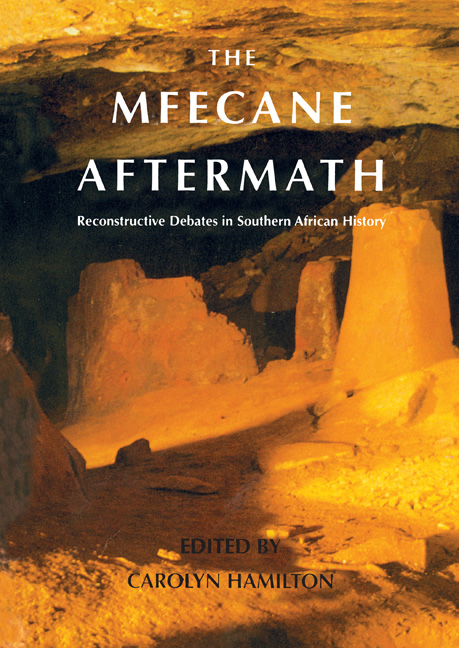Book contents
- Frontmatter
- Contents
- Maps
- Preface
- Acknowledgements
- Notes on Orthography and Names
- Contributors
- Introduction
- Part One Historiography and Methodology
- Part Two The South-Eastern Coastal Region
- Part Three The Interior
- ‘The Time of Troubles’: Difaqane in the Interior
- 11 Archaeological Indicators for Stress in the Western: Transvaal Region between the Seventeenth and Nineteenth Centuries
- 12 Prelude to Difaqane in the Interior of Southern Africa C.1600-C.1822
- 13 Conflict in the Western Highveld/Southern Kalahari c.1750-1820
- 14 ‘Hungry Wolves’: The Impact of Violence on Rolong Life, 1823-1836
- 15 The Battle of Dithakong and ‘Mfecane’ Theory
- 16 Untapped Sources: Slave Exports from Southern and Central Namibia up to c. 1850
- Glossary
- Abbreviations
- Bibliographer's Note
- Bibliography
- Complete List of Papers Presented at the Colloquium
- Index
12 - Prelude to Difaqane in the Interior of Southern Africa C.1600-C.1822
from Part Three - The Interior
Published online by Cambridge University Press: 31 May 2019
- Frontmatter
- Contents
- Maps
- Preface
- Acknowledgements
- Notes on Orthography and Names
- Contributors
- Introduction
- Part One Historiography and Methodology
- Part Two The South-Eastern Coastal Region
- Part Three The Interior
- ‘The Time of Troubles’: Difaqane in the Interior
- 11 Archaeological Indicators for Stress in the Western: Transvaal Region between the Seventeenth and Nineteenth Centuries
- 12 Prelude to Difaqane in the Interior of Southern Africa C.1600-C.1822
- 13 Conflict in the Western Highveld/Southern Kalahari c.1750-1820
- 14 ‘Hungry Wolves’: The Impact of Violence on Rolong Life, 1823-1836
- 15 The Battle of Dithakong and ‘Mfecane’ Theory
- 16 Untapped Sources: Slave Exports from Southern and Central Namibia up to c. 1850
- Glossary
- Abbreviations
- Bibliographer's Note
- Bibliography
- Complete List of Papers Presented at the Colloquium
- Index
Summary
… the eighteenth century in South Africa appears to have been a period of general restlessness and instability - of fissions, splinterings and hivings off. It seems to have been the beginning of the volkerwanderung that reached its crescendo with the more dramatic encounters and upheavals of the Difaqane during the first half of the next century. In such an environment of restlessness and uncertainty, it was the soldier kings or rulers that tended to succeed.
Leonard Diniso Ngcongco 'Aspects of the History of Bangwaketse to 1910'The difaqane wars around the area of the later Transvaal/Orange Free State are usually assumed to have begun in about 1822, after invasions from the east across the Drakensberg. But general restlessness and instability began much earlier - as Ngcongco indicates above - with a rising tide of violence from the later eighteenth century that cannot be clearly distinguished from the beginnings of the so-called difaqane in about 1822.
This essay looks at ways in which historians can use the findings of oral traditions and archaeology to reconstruct ‘pre-difaqane’ and ‘proto-difaqane’ periods of increasingly general crisis from the seventeenth up to the early nineteenth century. Understanding of these ‘pre-’ and ‘proto-’ periods should not only increase our understanding of the so-called difaqane/mfecane, but should also help to push back the frontiers of history - the continuous story of identifiable people - into the misty realms of prehistory.
Available oral traditions of the seventeenth and eighteenth centuries were mostly collected from Sotho/Tswana/Pedi-speaking elders, by European missionaries or officials and African intellectuals, before 1940. They tell of the growth of royal lineages, the spread of small states and small migrations of people. Mid-twentiethcentury historians, drawing on the perspectives of anthropology and nuclear physics, saw these traditions as evidence of structural processes of ‘fission’ and ‘fusion’ at work in precolonial societies. Later twentieth-century historians, drawing on the perspectives of archaeologists and environmentalists, have emphasised the importance of climatic changes in determining political-economic developments.
- Type
- Chapter
- Information
- Mfecane AftermathReconstructive Debates in Southern African History, pp. 323 - 350Publisher: Wits University PressPrint publication year: 1995



